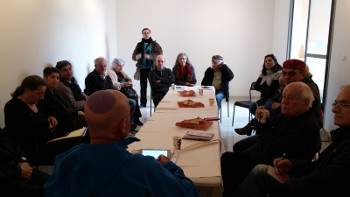Home > Oasis of Peace > Projects & Outreach > Doumia-Sakinah: The Pluralistic Spiritual Centre > The Garden of Rescuers > Forest of the Righteous - Planning Meeting
Forest of the Righteous - Planning Meeting
Thursday 10 March 2016

First Extended Planning Meeting
On January 15, 2016 at Wahat al-Salam – Neve Shalom (WAS-NS), the Museum conducted the first extended planning meeting for the Forest of the Righteous project. The plan is to create a unique tribute that will memorialize “the righteous”: i.e., those who have acted in tragic times to save the lives of others, risking their own lives and those of their loved ones (see Declaration below). The meeting was initiated by the Museum and attended by members of the WAS-NS community, as well as artists, educators, intellectuals and academics.
Based on conclusions from the meeting, we propose the following:
The Concept
- To develop a forest to commemorate the righteous, who, in various societies around the world, acted to save others during situations of holocaust, genocide, ethnic cleansing , harsh persecution or crimes against humanity.
- The forest will be located in the vicinity of the Pluralistic Spiritual Community Center of WAS-NS;
- The Forest will be part of the WAS-NS community’s peace education institutions;
- The Forest will be a symbol of heroism of individuals (anywhere in the world) on behalf of peace, dialogue, acceptance of the other, and the humane hope for the victory of love over hatred.
Conclusions
Everyone attending the meeting agreed that we should continue to consider and to plan the project. The values of WAS-NS and the educational and community projects should be taken into consideration, as well as sensitivity towards the feelings of the participants.
Content of the Discussion
- Those participating in the meeting developed the concept of how the commemoration should be made. The central idea and pedagogy is to instill the idea of the responsibility of each individual to act, especially in times of conflict and danger,.
- We will develop the idea conscientiously. Those working on it will need to invest time and energy in thinking about and reviewing choice of words, ethical foundations and emotions likely to be evoked, as well as other important aspects that are part of such a project.
- It is advised to map out the obstacles, opportunities, risks and messages of the project. Also the criterion for recognition and inclusion of righteous.
- At the heart of the educational idea will be the integration of personal stories and the site’s environment, as well as the building of familiarity with the individuals being commemorated.
- Academic research is central to the project. It is imperative to define the connection between academic history and the art of educating, without compromising the quality and accuracy of the facts.
- Because of the desire to develop a universal-human site, it is important to be sensitive to the Israeli-Palestinian relationship. In addition, it is important to pay attention to the dangers in emphasizing the role of the aggressor rather than that of the righteous.
- The project should develop through a constructive interchange with members of the WAS-NS community as well as with input from other communities and concerned individuals from the country and the world.
- The project will aim to be experiential, multi-sensory, active, rather than passive.
- With the building of the project, we will establish objectives for success that staff will use to evaluate the effectiveness and efficiency of the project.
Next Steps
- Approval of this summary by the coordinators.
- Presenting the summary for approval to the community institutions of WAS-NS (already accomplished).
- Sending the summary to the participants of the meeting and obtaining feedback.
- Getting approval from the community institutions to carry out the project; appointment of staff; and determining how to continue the process.
* The next meeting will take place at the beginning of April 2016.
Declaration
Honoring the Righteous:
There are those who, during dark periods of humanitarian disasters, ethnic cleansing and genocide, did not succumb to the popular current. They were able to view reality with their own eyes and bravely act to save lives.
Their stories will cast light upon our own life and times.
Filled with moral and educational values, these stories provide a model to be emulated.
We have chosen to turn them into a living memory that educates and creates an awareness that can shape our experience and future.
To date, we have looked at honoring the heroism of Palestinians and other Arabs who saved the lives of Jews and Jews who saved lives of the Palestinians and other Arabs.
We commemorated Armenians who saved lives of Jews, Turks who saved lives of Armenians, honoring all those whose names have not yet been revealed. We will continue in this way to memorialize others.
We are working with Gariwo: Gardens of the Righteous Worldwide, of which we are opening a branch in our community.
We thank those who have been working with us on this important project and the organizations who will join us as we continue to develop the project.
